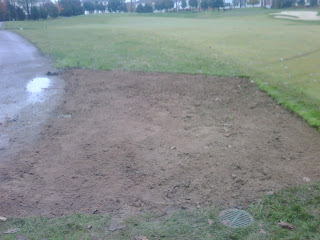The first question most people ask the golf maintenance industry is, “what do you do in the winter months”? Well, that’s a great question. As mowing activities slow and the growing season comes to an end, operations shift to tasks such as drainage.
The true definition of drainage is the natural or artificial removal of surface and sub-surface water from an area. Recently, the fifteenth hole next to the cart path received a bit of both. The turf was removed along with accumulated sediment. (Photo #1) Next, four inch pipe was installed to pick up any subsurface water, in conjunction with catch basins to collect excess water flow from the cart path. The trenches were then filled with stone, allowing water to travel into the pipe. (Photo #2) The entire area was graded and smoothed to prepare for sod. (Photo #3) The area now has sod and is ready for play! (Photo #4) There are similar areas that will be addressed as the winter continues.
We’d like to hear from you, leave your comments about this blog below.








